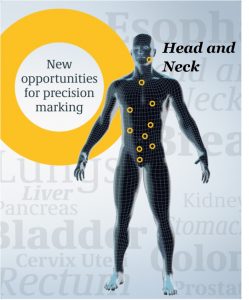Head and neck cancer
Intraoperative injections of BioXmark® represent a promising option in head and neck cancer treatment
The markers can help identify tumor resection surfaces in CT imaging for RT planning and follow-up

BioXmark® for high-precision radiation therapy of head and neck cancer – White paper
Discover BioXmark® advantages and clinical evidence for head and neck cancer radiation therapy:
BioXmark® can facilitate precision radiation therapy for head and neck cancer
A clinical study by Steybe et al. concludes that intraoperative injection of BioXmark®
“can be considered a promising option to facilitate identification of the tumor resection surface in postoperative CT imaging for RT planning and follow-up imaging”(1).
Click to read the study publication
Facts about head and neck cancer
The term “head and neck cancer” is commonly used to describe several different cancers of the head and neck region including cancers of larynx, pharynx, lip and oral cavity, salivary glands, paranasal sinuses and nasal cavity(2).
Head and neck cancer is the 7th most common cancer in North America and Europe(3). The cancers of the oral cavity and lips, larynx and pharynx are the most common head and neck cancers, while cancers of the salivary glands and paranasal sinuses and nasal cavity are less common(4).
Alcohol, tobacco use and infection with cancer causing types of human papillomavirus (HPV) are among the most important risk factors for head and neck cancers(4).
Clinical presentation and diagnosis
Head and neck cancers may present with different symptoms depending on the specific type, but common symptoms include a sore throat that does not go away, difficulty in swallowing, hoarseness of the voice, a lump in the neck, or a sore in the mouth or the throat that cannot heal.
The diagnostic evaluation of patients with suspected head and neck cancer includes a thorough ear, nose and throat examination, including video laryngo- and pharyngoscopy and ultrasound. Further evaluation includes CT, MR and/or PET/CT scanning and biopsy for pathology analysis(5).
Treatment
The treatment plan for head and neck cancer depends on many factors including the specific cancer type, and its stage as well as the patient’s age and general health and comorbidities. Treatment options can include surgery, radiation therapy, chemotherapy, targeted therapy, immunotherapy or a combination of therapies(4).
Radiotherapy for head and neck cancer
In general, radiotherapy plays an important role in the treatment of head and neck cancer and can, potentially, be curative. For many primary head and neck cancers, radiotherapy yields better functional outcomes than surgery and is often preferred for localized disease. For locoregionally advanced head and neck cancers, radiotherapy is often used in combination with chemotherapy as a definitive organ function-preserving approach, or after surgery as adjuvant postoperative radiotherapy(6).
How can BioXmark® add value in the treatment of patients with head and neck cancer?
The use of BioXmark® in connection with radiotherapy of head and neck cancer has been demonstrated by Dr. Steybe and colleagues from the University of Freiburg. They showed that a high number of BioXmark® markers (>60) (10-30 µl) is a feasible approach to mark oral soft tissue resection surfaces(1). This approach made it feasible to create a 3D grid structure for visualization of the tumor bed cavity in head and neck cancer.
In the clinical study one patient had 66 BioXmark® markers (64 × 10 μl; 2 × 30 μl) injected at the soft tissue tumor resection surface after undergoing surgical resection of a squamous cell carcinoma, located at the base and lateral margin of the tongue, while the other patient had 52 markers (48 × 10 μl; 4 × 30 μl) injected after resection of a tumor of the parotid gland and undergoing defect reconstruction with a scapula and latissimus dorsi flap.
The study showed that BioXmark® in volumes of 10 μl is visible in the head and neck region on CT imaging at kV settings applied in clinical routine and that 30 μl injections were distinguishable from 10 μl injections.
The study concludes that intraoperative injection of BioXmark® “can be considered a promising option to facilitate identification of the tumor resection surface in postoperative CT imaging for RT planning and follow-up imaging”.
References
1.
Steybe D, Poxleitner P, Voss PJ, Metzger MC, Schmelzeisen R, Bamberg F, et al. Evaluation of computed tomography settings in the context of visualization and discrimination of low dose injections of a novel liquid soft tissue fiducial marker in head and neck imaging. BMC Med Imaging. 2021 Oct 27;21(1):157
2.
DeVita VT, Lawrence TS, Rosenberg SA, editors. DeVita, Hellman, and Rosenberg’s cancer: principles & practice of oncology. 11th edition. Philadelphia: Wolters Kluwer; 2019. 2390 p
3.
GLOBOCAN 2020. Ferlay J, Ervik M, Lam F, Colombet M, Mery L, Piñeros M, Znaor A, Soerjomataram I, Bray F (2020). Global Cancer Observatory: Cancer Today. Lyon, France: International Agency for Research on Cancer. [Internet]. [cited 2022 Mar 10]. Available from: http://gco.iarc.fr/today/home
4.
Head and Neck Cancers – National Cancer Institute [Internet]. [cited 2022 Mar 29]. Available from: https://www.cancer.gov/types/head-and-neck/head-neck-fact-sheet#r1
5.
Head and neck cancer treatment program. For professionals. (in Danish: Pakkeforløb for hoved- og halskræft. For fagfolk). Published by the Danish Health Authority (in Danish: Sundhedsstyrelsen). 2020 Jun;
6.
General principles of radiation therapy for head and neck cancer – UpToDate [Internet]. [cited 2022 Mar 29]. Available from: https://www.uptodate.com/contents/general-principles-of-radiation-therapy-for-head-and-neck-cancer
